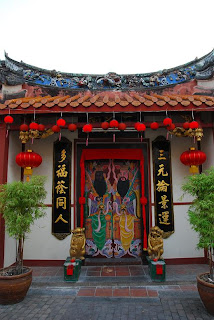
Buildingconservation.blogspot.com
In the heart of Melaka's old town is Jalan Tukang Emas (GoldsmithRoad) Jalan Tukang Besi (Blacksmith Road) and Jalan Tokong(Temple Street); renowned for many religious places of worship.
The deflected and curving nature of the streets that meander this part ofthe city creates a perfect sense of enclosure and exquisite townscape effect. The visual experience is heightened by the intricateness andvaried buildings in terms of façade design and building height. The streetnames, which took after the craftsmen of old Melaka, reflected theimportance of this area as the once artisan zone for the city. Tinsmith,blacksmith, cobblers, coffin-makers, paper artisan and basket weaversstill ply their trades here.
The other unique feature of the streets is the presence of three different types of places of worship namely; ChengHoon Teng Temple, The Masjid Kampong Kling and the Sri PoyyathaVinagar Moorthi Temple. Although the area is now predominantlyoccupied by Chinese, the presence of the mosque and the Indian temple suggests that this area was once lived by a multi ethnic community that was able to live harmoniously together.
The Cheng Hoon Teng temple isover 300 years old and was founded by Li Kup who fled China when theManchus toppled the Ming. It is still the major place of worship for the Chinese in Melaka and is the oldest functioning Chinese Temple in the country.

Wikipedia ... The Cheng Hoon Teng temple (青云亭) is a Buddhist temple in Jalan Tokong, Malacca, Malaysia. It is the oldest functioning temple in Malaysia.
The richly decorated Cheng Hoon Teng temple covers an area of 4,600 square metres.
Featuring a magnificent main gate along Jalan Tokong, the Cheng Hoon Teng temple consists of a complex of several prayer halls, with a large main prayer hall dedicated to the goddess of mercy, Kuan Yin. Additional smaller prayer quarters were added later. One of these is dedicated to the Taoist gods of wealth, longevity and propagation, while another houses ancestral tablets.


One of the most dramatic features of Cheng Hoon Teng temple is the seven-metre red flag-pole facing the left wing of the main prayer hall, which houses the remains of two of the three Kapitans who contributed to the construction of the temple. Across the road is a traditional opera theatre, which forms a part of the Cheng Hoon Teng temple complex.
The building conforms to the principles of feng shui. The complex is laid out to ensure a view of the river and high ground on either side.
History
Built in 1645 by Kapitan Lee Wei King with building materials imported from China, Cheng Hoon Teng served as the main place of worship for the local Hoklo (Hokkien) community. The main hall was built by Kapitan Chan Ki Lock in 1704 and was rebuilt in 1801 by Kapitan China Chua Su Cheong, who contributed to the aesthetic and magnificent structural additions of the building.
In 1962, then abbot Seck Kim Seng ordained Houn Jiyu-Kennett, a Zen nun from England and the future founder of the Order of Buddhist Contemplatives, at this temple.
In 2003, Cheng Hoon Teng was awarded a UNESCO award for outstanding architectural restoration.







Neighbouring this magnificent and well preserved temple ... Masjid Kampung Kling.


Another ornate entrance nearby...


No comments:
Post a Comment